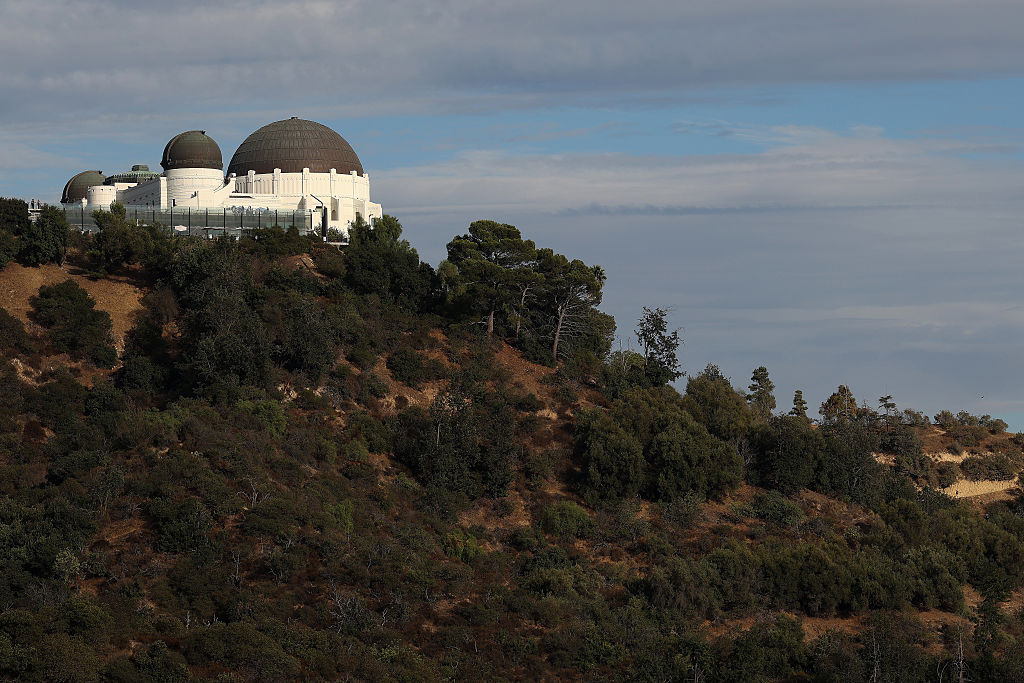The magnificent Griffith Park Observatory turned 90 this year and, as fans of nonagenarians, my wife and I hiked up the south slope of Mount Hollywood – well, our rental car did the hard work – to pay our respects.
The city of Los Angeles sprawled out before us; the Hollywood sign loomed ominously above us. I suppose I should hate this city, the Typhoid Mary of cultural imperialism, infecting and deadening imaginations from Bangor to Bend. As Morrissey crooned: “We look to Los Angeles for the language we use/ London is dead.”
But I dunno: it’s my wife’s hometown, I love her Armenian relatives and I’ve always been a sucker for the movies, at least in their pre-CGI, pre-Marvel, pre-woke, pre-franchise age.
Griffith Park is something of a sentimental spot for us, as Lucine and I once reenacted the Observatory knife fight scene from Rebel Without a Cause here, sans cutlery, way back where the past was. So the first thing we did on this visit was scoot toward the Kenneth Kendall-sculpted bust of James Dean on the west side of the Observatory lawn.
Several dozen gamesome schoolchildren were horsing around on the grounds, none paying the slightest attention to the brooding Hoosier overactor’s bronze visage, but it’s hard to score the LA School District for deficiencies in teaching film history: Rebel was released 70 years ago, so teenagers today are as unlikely to know, much less idolize, Dean as I would have been to have drooled over Florence Lawrence at their age.
Then again, kids these days listen to the Doors and wear Beatles T-shirts, digging the pop music of threescore years earlier, though I rather doubt that many flowerchildren of the 1960s were grooving to “Yes, We Have No Bananas” or the “Swanee” stylings of Al Jolson.
The James Dean bust – which the actor himself commissioned – is accompanied by an inscription that calls him “an American original who on a basis of high school honors and in a period of five years time rose to the very pinnacle of the theatrical profession and through the magic of motion pictures lives on in legend.”
Speaking of the very pinnacle, Lucine snapped a shot of me standing in front of the Griffith Park Observatory’s Astronomers Monument, a 35-foot high sculpture featuring likenesses of the stellar sextet of Galileo, Isaac Newton, Copernicus, Kepler, Hipparchus and William Herschel. I titled the photo “Seven Great Astronomers.”
I share a birthday with Herschel, discoverer of Uranus – and isn’t the seventh planet from the sun the favorite planet of every giggling 12-year-old boy? Uranus has not yet been canceled by planetary puritans – unlike its little brother Pluto, victim of microphobic astronomers. The erstwhile ninth planet’s demotion to the demeaning status of “dwarf planet” (no offense to little people) still pisses me off.
I once interviewed David Levy, the greatest comet hunter of our age. He knew Pluto’s discoverer, Clyde Tombaugh, whose biography he wrote. Levy told me that the elderly Tombaugh feared that his ejection from the exclusive Planet Discoverers Club was only a matter of time. At least the members of the International Astronomical Union had the minimal decency to wait until Clyde was dead before they committed their foul deed. (Mike Brown’s How I Killed Pluto and Why It Had It Coming is a lively account by the chief murderer.)
Yet I was glad to see that the Pluto plaque remains firmly in the ground of Griffith Park’s Solar System Lawn Model. It hasn’t been dug up by the planetary precisians yet.
The eccentric musician Sufjan Stevens, who once claimed – tongue somewhat in cheek – the extraordinarily inspired ambition of devoting an album to each of the 50 states, recorded an instrumental, “For Clyde Tombaugh,” as part of his Illinois effort. Stevens only musicalized two states, the other being his native Michigan, but his was a rare pop-culture recognition that the states are not just administrative units of a national behemoth, as nanny-state progressives and power-mad Trumpsters seem to believe. They are real places with real histories, distinct and individuated and idiosyncratic and tragic and funny.
In one of his best tunes, the late folksinger Phil Ochs hymned “Jim Dean of Indiana” and I suppose Stevens would have packed Dean into an Indiana album, standing at a cool remove from his fellow subjects Larry Bird and Kurt Vonnegut and Theodore Dreiser and the Jackson 5 and Eugene V. Debs and Booth Tarkington.
We do not need to look to Los Angeles for the language we use – or to Washington, DC, for that matter.
This article was originally published in The Spectator’s November 10, 2025 World edition.


























Leave a Reply